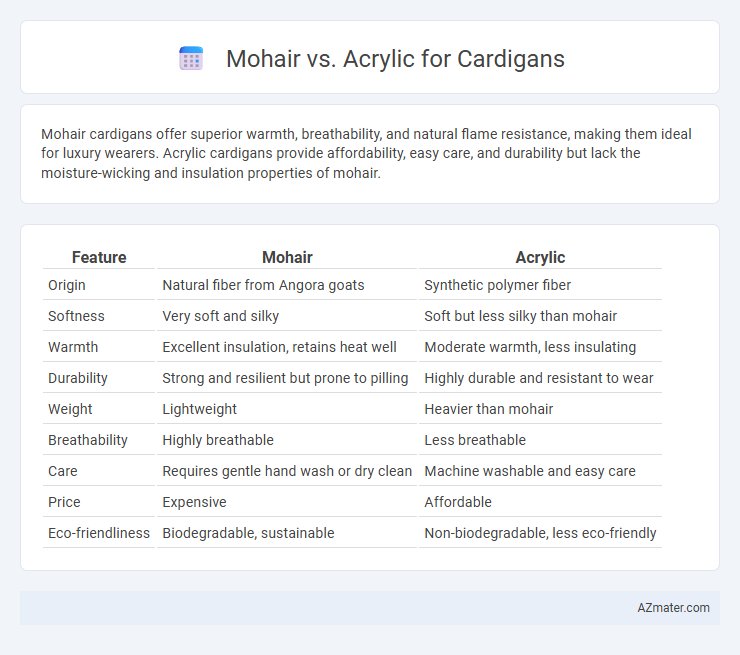Mohair cardigans offer superior warmth, breathability, and natural flame resistance, making them ideal for luxury wearers. Acrylic cardigans provide affordability, easy care, and durability but lack the moisture-wicking and insulation properties of mohair.
Table of Comparison
| Feature | Mohair | Acrylic |
|---|---|---|
| Origin | Natural fiber from Angora goats | Synthetic polymer fiber |
| Softness | Very soft and silky | Soft but less silky than mohair |
| Warmth | Excellent insulation, retains heat well | Moderate warmth, less insulating |
| Durability | Strong and resilient but prone to pilling | Highly durable and resistant to wear |
| Weight | Lightweight | Heavier than mohair |
| Breathability | Highly breathable | Less breathable |
| Care | Requires gentle hand wash or dry clean | Machine washable and easy care |
| Price | Expensive | Affordable |
| Eco-friendliness | Biodegradable, sustainable | Non-biodegradable, less eco-friendly |
Introduction to Mohair and Acrylic
Mohair is a luxury natural fiber derived from the Angora goat, prized for its silky texture, high durability, and excellent insulating properties, making it ideal for premium cardigans. Acrylic is a synthetic fiber known for its affordability, lightweight feel, and resistance to moisture and mold, commonly used as a substitute for natural fibers in cardigan production. The choice between mohair and acrylic influences the cardigan's warmth, breathability, and overall comfort.
Origins and Production Processes
Mohair originates from the Angora goat, primarily raised in South Africa and Turkey, with fibers known for their silk-like sheen and durability due to natural protein structures. Acrylic, a synthetic fiber developed in the mid-20th century, is produced through polymerization of acrylonitrile, offering a cost-effective and hypoallergenic alternative while relying on petrochemical processes. The natural sourcing and animal-derived nature of mohair contrast sharply with the industrial, chemical-intensive production of acrylic fibers used in cardigan manufacturing.
Texture and Feel Comparison
Mohair offers a luxurious, soft, and slightly fuzzy texture that feels warm and lightweight against the skin, making it ideal for cozy cardigans. Acrylic fibers, on the other hand, provide a smoother and less breathable texture that can sometimes feel synthetic or plastic-like but offers durability and easy care. The natural sheen and insulating properties of mohair create a premium feel, while acrylic cardigans emphasize affordability and practicality.
Warmth and Insulation Properties
Mohair fibers provide superior warmth and insulation for cardigans due to their natural crimp and hollow structure, which trap heat effectively while allowing breathability. Acrylic, a synthetic fiber, offers moderate warmth but lacks the moisture-wicking and temperature-regulating properties of mohair. Compared to acrylic, mohair cardigans retain heat better in cold conditions, making them ideal for insulation without heavy layering.
Durability and Longevity
Mohair cardigans are prized for their natural fibers, offering superior durability and resistance to pilling compared to acrylic. Acrylic cardigans may wear out faster with frequent use, showing signs of thinning and fiber breakage over time. Choosing mohair ensures a longer-lasting, resilient garment that maintains its texture and warmth through extended wear.
Breathability and Comfort
Mohair offers superior breathability and natural moisture-wicking properties, making it highly comfortable for cardigans, especially in varying temperatures. Acrylic, a synthetic fiber, tends to trap heat and moisture, which can reduce comfort and airflow during wear. Choosing mohair ensures enhanced ventilation and a softer texture, ideal for maintaining comfort throughout the day.
Care and Maintenance Requirements
Mohair cardigans require gentle care, including hand washing with cold water and mild detergent to preserve the fiber's softness and prevent shedding. Acrylic cardigans are more durable and machine washable, making them easier to maintain and less prone to pilling or shrinking. Proper storage for mohair involves avoiding direct sunlight and moisture, while acrylic items can be stored more flexibly without special precautions.
Pricing and Affordability
Mohair cardigans typically command higher prices due to the luxury and scarcity of natural fibers sourced from Angora goats, often ranging from $100 to $300 or more. Acrylic cardigans provide a budget-friendly alternative, with prices usually falling between $20 and $70, making them accessible for wider audiences. Durability and ease of care in acrylic blends contribute to their affordability compared to the delicate maintenance required for mohair garments.
Environmental Impact and Sustainability
Mohair, derived from Angora goats, is a biodegradable and renewable fiber with low environmental impact due to its natural production process, while acrylic is a synthetic fiber made from petroleum-based chemicals, contributing to pollution and non-biodegradability. The cultivation of mohair supports biodiversity and soil health, whereas acrylic manufacturing releases toxic emissions and microplastics that harm ecosystems. Choosing mohair cardigans reduces carbon footprint and waste accumulation, enhancing sustainability compared to acrylic alternatives.
Choosing the Best Yarn for Your Cardigan
Mohair yarn offers a luxurious, soft texture with excellent warmth and natural breathability, making it ideal for lightweight yet cozy cardigans. Acrylic yarn provides durability, easy care, and affordability, perfect for everyday wear and allergy-sensitive individuals. Selecting the best yarn depends on your priorities: choose mohair for elegance and insulation, or acrylic for practicality and budget-friendly versatility.

Infographic: Mohair vs Acrylic for Cardigan
 azmater.com
azmater.com